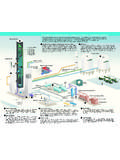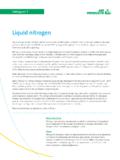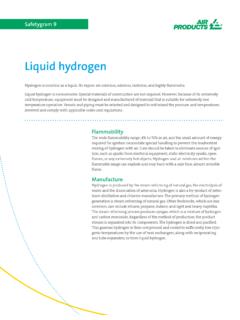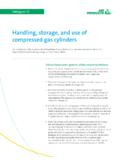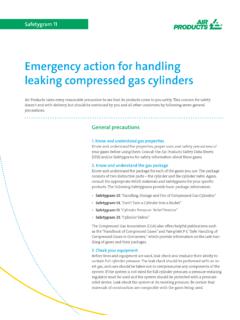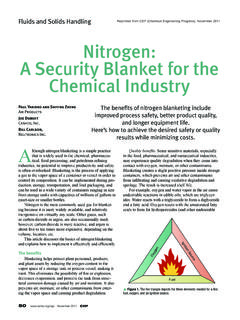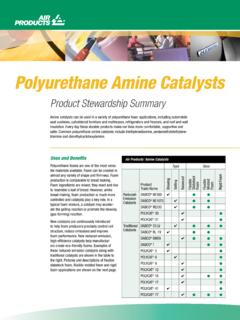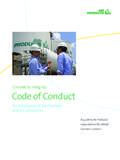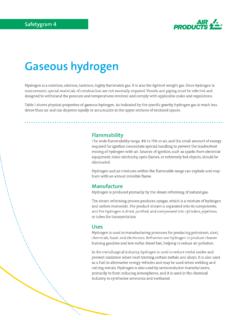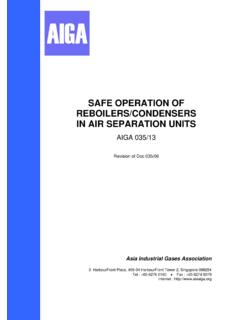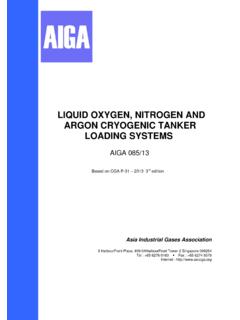Transcription of Cryogenic liquid containers - Air Products & Chemicals
1 Safetygram 27. Cryogenic liquid containers Cryogenic liquid containers , also referred to as liquid cylinders, are double-walled vacuum vessels with multilayer insulation in the annular space. They are designed for the reliable and economic transportation and storage of liquefied gases at Cryogenic temperatures, typically colder than 130 F ( 90 C). There are two primary advantages of a liquid container . The first is that it contains a large volume of gas at a relatively low pressure compared to a compressed gas cylinder. The second is that it provides a source of Cryogenic liquids which can be easily handled. Cryogenic liquid containers are often incorrectly referred to as dewars. Dewars are open, nonpressurized vessels for holding Cryogenic liquids. The Cryogenic Products normally found in liquid containers are liquid nitrogen (LIN), liquid argon (LAR), liquid oxygen (LOX), and liquid helium (LHE).
2 Carbon dioxide and nitrous oxide are also available as refrigerated liquids in similar containers . Although these containers are well insulated, heat will continuously leak into the product , due to the extremely large temperature difference between the Cryogenic liquid and the ambient environment. The heat leak will cause some vaporization to occur. Vaporized product , if not used, will collect in the vapor space above the liquid and build pressure. This is referred to as head pressure. The head pressure will build in the container and periodically vent via the pressure relief valve. Vaporization rates will vary and may be as low as or as high as 3% of the container 's volume per day. This is a normal and safe function of the container . The user of any Cryogenic liquid container should be thoroughly familiar with the product and the mechanical work- ings of the container before using the product .
3 General safety precautions The potential hazards for handling Cryogenic liquids, in addition to those observed for their respective gases, stem from two properties: extremely cold temperature and the expansion ratio. The extremely cold temperatures of Cryogenic liquids can rapidly freeze hu- man tissue. Leather or insulated gloves and other protective clothing should be worn when operating valves or when the potential exists for contact with product or exposed cold piping. This includes long cuffless pants, long-sleeved shirt, safety glasses, and full face shield. All Cryogenic liquids produce large If liquid oxygen is released, an Figure 1: Avoid Trapping a Cryogen volumes of gas when they vaporize. oxygen-enriched atmosphere could The expansion ratio is the amount of result.
4 An oxygen-enriched atmo- Pressure relief valve gas generated from a given amount sphere is dangerous due to the of liquid . Table 1 shows the liquid -to- increased potential for a fire to occur. Valve Valve gas expansion ratios for the common Although oxygen itself is nonflam- Cryogenic fluids. If a sufficient amount mable, ordinary combustible materials of liquid is vaporized within a closed will burn more vigorously. Materials container , it will produce enormous that normally do not burn in air liquid cryogen pipe pressures that could rupture the ves- may burn in an oxygen-enriched sel. For this reason, Cryogenic liquid atmosphere. containers are protected with mul- tiple pressure relief devices. Similarly, Table 1: Expansion Ratios at 70 F of Common Cryogenic Fluids ( liquid to Gas*).
5 Any system for the storage and Cryogenic liquid Expansion Ratio delivery of Cryogenic liquids should be Argon 1 to 841. carefully designed to avoid trapping Helium 1 to 754. Cryogenic liquid at any point in the Hydrogen 1 to 848. system by installing a relief device as Nitrogen 1 to 696. depicted in Figure 1. Oxygen 1 to 861. If liquid nitrogen, argon or helium is * For example, 1 cubic foot of liquid argon will create 841 cubic feet of gaseous argon at 70 F. accidentally released in a confined space, a dangerous oxygen-deficient atmosphere could be created. Use and Figure 2: containers May Be Supplied with Various Wheel Configurations store liquid containers in well- ventilated areas. The released gas will displace the oxygen concentra- tion in the air. A small spill of liquid will produce a large volume of gas, which can and will change the condi- tions of the ambient environment in a confined space very quickly.
6 For example, a spill of one cubic foot of liquid nitrogen will vaporize to 696. equivalent volumes of gas at 70 F. An oxygen-deficient atmosphere can lead to rapid asphyxiation (suffocation). This can cause loss of consciousness and may result in serious injury or death. Never enter an area where oxygen levels are below without the use of supplied air. The dangers of oxygen-deficient environments are discussed more fully in Air Products '. Safetygram-17, Dangers of Oxygen- Deficient Atmospheres.. 2. Handling and storage Table 2: Average Full and Empty Weights of Different liquid containers liquid containers are supplied in dif- Nominal Volumetric Capacity (liters) 160 180 230. ferent sizes. A typical 180-liter unit Physical Dimensions weighs approximately 260 pounds Empty Weight (lbs) 250 260 310.
7 (118 kg) when empty and as much as Filled Weight (lbs). 774 pounds (351 kg) when filled with Nitrogen 513 556 667. liquid argon. Table 2 lists nominal Oxygen 622 672 825. empty and full weights for common Argon 695 753 936. liquid containers . Due to their weight Diameter (inches) 20 20 24. and bulkiness, care must be taken Height (inches) 61 when handling and storing liquid con- liquid Storage Capacity, SCF* tainers. Mechanical handling devices Nitrogen 3637 4088 4939. should always be used to move them if they are not already equipped with Oxygen 4500 4680 6224. wheels. Argon 4310 4775 6056. Gas Delivery Rate, SCFH 325 325 350. Handling * DOT MAX @ 235 PSIG Safety liquid containers must only be un- loaded from or loaded onto a delivery vehicle by means of a crane, fork Elevator transport Storage truck, or a power-assisted tailgate.
8 Care must be exercised when trans- liquid containers should always be liquid containers may be moved us- porting liquid containers in elevators. stored in an upright position. Despite ing a forklift if they are secured on a If possible, transport the container the superinsulation used in liquid pallet, in a cradle, or some other device only on a freight elevator that is not containers , some heat leak is unavoid- designed for this purpose. When the generally used for personnel trans- able. As a result, when product is not container is removed from a pallet, it port. After the container is placed in being withdrawn, pressure within the should only be moved using a spe- the elevator, the elevator should be container will gradually increase, due cially designed four-wheel handcart.
9 Locked out to all other users. The send- to the small amount of liquid product liquid containers should only be er should remain outside the elevator vaporized by the heat leak. Pressure transported in an upright position and activate it. Another person should builds up until the pressure relief and should never be laid on their side. be available on the receiving floor to device functions and then reseats. See Figure 3 for proper ways to handle take the liquid container off the eleva- This type of venting is usually normal a liquid container . Never roll these tor at its destination. If a freight eleva- and indicates the container is being containers on their side. tor is not available, a passenger eleva- protected from over-pressurization. tor can be used provided it is locked Therefore, it is recommended that liquid containers equipped with out to all other users.
10 If it is absolutely liquid containers are stored and used wheels should always be moved by necessary to have an attendant in the in well-ventilated areas or areas with pushing the container , never pulling elevator with the container , an escape forced ventilation. If this is not pos- it. This reduces the possibility of the pack supplemental breathing appara- sible, monitoring of the area for oxy- container falling on you or a coworker tus must be carried in the elevator. Do gen concentration is essential. Storage in the event it becomes unstable. not transport a liquid container at any areas, in addition to being well venti- Figure 4 depicts how to properly move time in an elevator with any other lated, should be secure and protected a liquid container . Pushing the liquid personnel in the car.
